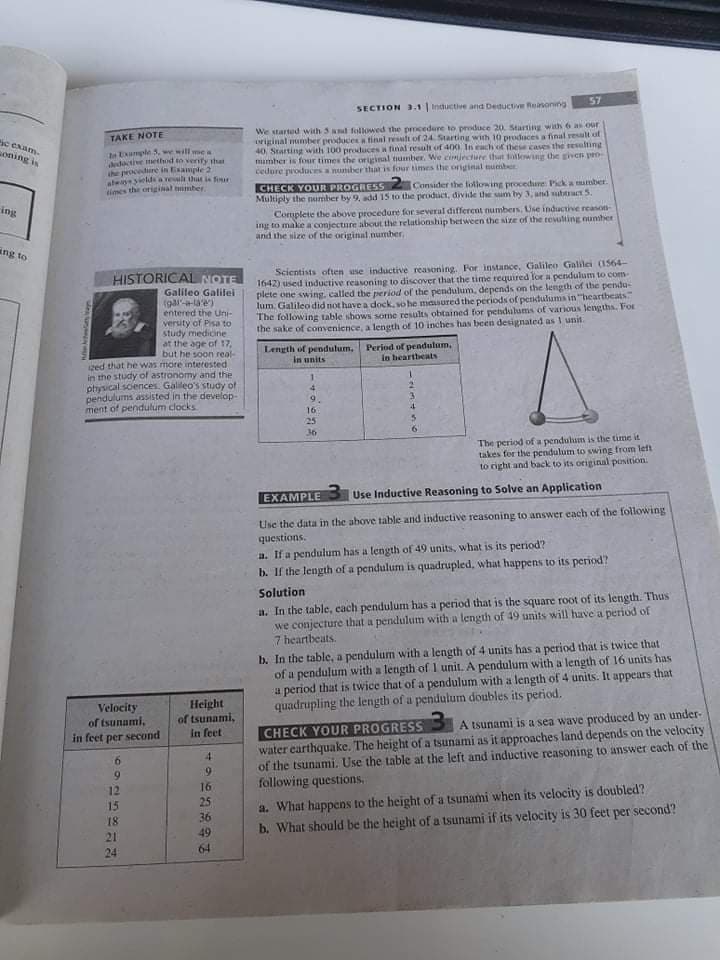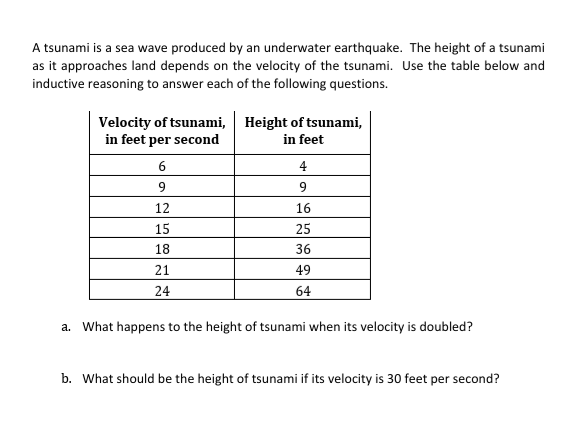A tsunami is a sea wave produced by an underwater earthquake. The height of a tsunami as it approaches land depends on the velocity of the tsunami. Use the table below and inductive reasoning to answer each of the following questions. Velocity of tsunami, in feet per second Height of tsunami, in feet 6 4 9 9 12 16 15 25 18 36 21 49 24 64 a. What happens to the height of tsunami when its velocity is doubled? b. What should be the height of tsunami if its velocity is 30 feet per second?
A tsunami is a sea wave produced by an underwater earthquake. The height of a tsunami as it approaches land depends on the velocity of the tsunami. Use the table below and inductive reasoning to answer each of the following questions. Velocity of tsunami, in feet per second Height of tsunami, in feet 6 4 9 9 12 16 15 25 18 36 21 49 24 64 a. What happens to the height of tsunami when its velocity is doubled? b. What should be the height of tsunami if its velocity is 30 feet per second?
University Physics Volume 1
18th Edition
ISBN:9781938168277
Author:William Moebs, Samuel J. Ling, Jeff Sanny
Publisher:William Moebs, Samuel J. Ling, Jeff Sanny
Chapter16: Waves
Section: Chapter Questions
Problem 43P: (a) Seismographs measure the arrival times of earthquakes with a precision of 0.100 s. To get the...
Related questions
Question
Answers from an expert in as fast as 30 minutes!

Transcribed Image Text:57
SECTION 3-1 | Inductive and Deductive Reinoning
We started with 3 nd followed the pocedere to produce 20. Starting withs 6 as our
original number produces atinal resuli of 24 Starting with 100 produces a final result of
40 Starting with 100 produces a final result of 400 In each of these cases the resulting
mumber is four times the original tumber. We eimjecture that tattewing the given yeo
cedure produces a nuniber that is four times the orginal number
jc exam-
TAKE NOTE
e Exumple 5, we will e w
edoctive method to verify that
the procedire in Exampde 2
eteneSields a reilt thuat is four
imes the original mber.
oning is
Consider the following procedure: Picka amber.
CHECK YOUR PROGRESS
Multiply the number by 9, add 15 to the product, divide the wim by 3, and subtra 5.
Complete the above procedure for several different numbers, Use inductive reason
ing to make a conjecture about the relationship between the size of the teulting nunber
and the size of the original number,
ing
ang to
Scientists often use inductive reasoning For instance, Galileo Galilei (1564-
1642) used inductive reasoning to discover that the time rcquired for a pendulum to com
plete one swing, called the period of the pendulum, depends on the length of the pendu-
lum. Galileo did not have a dock, so he masured the periods of pendulums in "heartbeats
The following table shows some results obtained for petndulums of various lengtha. For
the sake of convenience, a length of 10 inches has been designated as I unit.
HISTORICAL NOTE
Galileo Galifei
(gar-lae)
entered the Un-
versity of Pisa to
study medicine
at the age of 17,
but he soon real-
zed that he was more interested
in the study of astronomy and the
physical scences. Galeo's study of
pendulums assisted in the develop-
Length of pendulum, Period of pendulum,
in heartheats
In units
4
ment of pendulum clocks
16
25
9.
36
The period of a pendulum is the time it
takes for the pendulum to swing from left
to cight and back to its original position.
EXAMPLE
Use Inductive Reasoning to Solve an Application
Use the data in the above table and inductive reasoning to answer each of the following
questions.
a. If a pendulum has a length of 49 units, what is its period?
b. If the length of a pendulum is quadrupled, what happens to its period?
Solution
a. In the table, cach pendulum has a period that is the square root of its length. Thus
we conjecture that a pendulum with a length of 49 units will have a period of
7 heartbeats.
b. In the table, a pendulum with a length of 4 units has a period that is twice that
of a pendulum with a length of I unit. A pendulum with a length of 16 units has
a period that is twice that of a pendulum with a length of 4 units. It appears that
quadrupling the length of a pendulum doubles its period.
Velocity
of tsunami,
in feet per second
Height
of tsunami,
in feet
CHECK YOUR PROGRESS S A tsunami is a sea wave produced by an under-
water earthquake. The height of a tsunami as it approaches land depends on the velocity
of the tsunami. Use the table at the left and inductive reasoning to answer each of the
following questions,
4.
9.
16
25
36
12
15
18
a. What happens to the height of a tsunami when its velocity is doubled?
49
b. What should be the height of a tsunami if its velocity is 30 feet per second?
21
24
64

Transcribed Image Text:A tsunami is a sea wave produced by an underwater earthquake. The height of a tsunami
as it approaches land depends on the velocity of the tsunami. Use the table below and
inductive reasoning to answer each of the following questions.
Velocity of tsunami, Height of tsunami,
in feet per second
in feet
6
4
9
9
12
16
15
25
18
36
21
49
24
64
a. What happens to the height of tsunami when its velocity is doubled?
b. What should be the height of tsunami if its velocity is 30 feet per second?
Expert Solution
This question has been solved!
Explore an expertly crafted, step-by-step solution for a thorough understanding of key concepts.
Step by step
Solved in 2 steps with 2 images

Knowledge Booster
Learn more about
Need a deep-dive on the concept behind this application? Look no further. Learn more about this topic, physics and related others by exploring similar questions and additional content below.Recommended textbooks for you

University Physics Volume 1
Physics
ISBN:
9781938168277
Author:
William Moebs, Samuel J. Ling, Jeff Sanny
Publisher:
OpenStax - Rice University


Glencoe Physics: Principles and Problems, Student…
Physics
ISBN:
9780078807213
Author:
Paul W. Zitzewitz
Publisher:
Glencoe/McGraw-Hill

University Physics Volume 1
Physics
ISBN:
9781938168277
Author:
William Moebs, Samuel J. Ling, Jeff Sanny
Publisher:
OpenStax - Rice University


Glencoe Physics: Principles and Problems, Student…
Physics
ISBN:
9780078807213
Author:
Paul W. Zitzewitz
Publisher:
Glencoe/McGraw-Hill

Astronomy
Physics
ISBN:
9781938168284
Author:
Andrew Fraknoi; David Morrison; Sidney C. Wolff
Publisher:
OpenStax